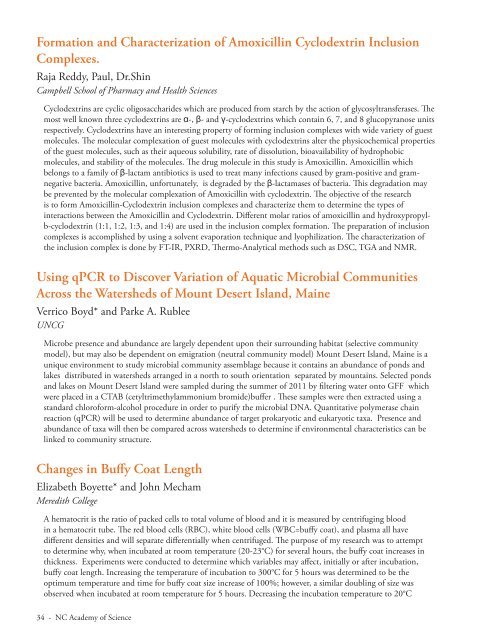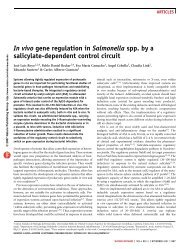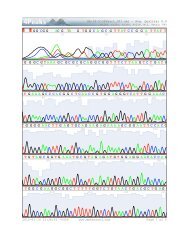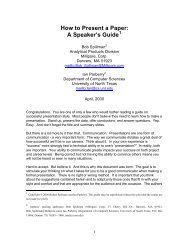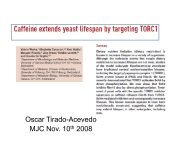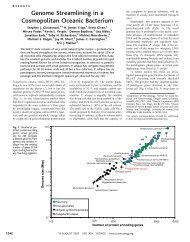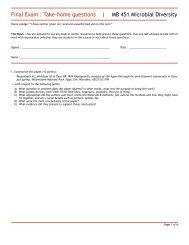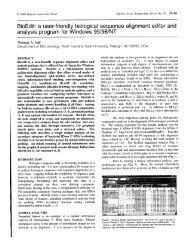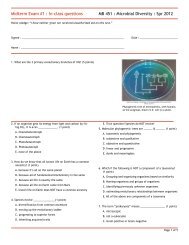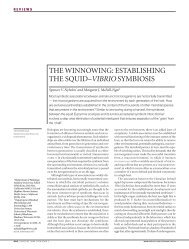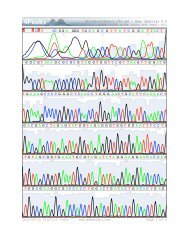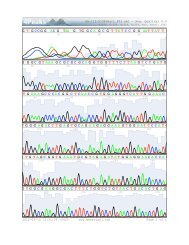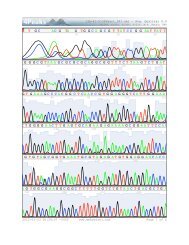Schedule and Program - North Carolina Academy of Science
Schedule and Program - North Carolina Academy of Science
Schedule and Program - North Carolina Academy of Science
You also want an ePaper? Increase the reach of your titles
YUMPU automatically turns print PDFs into web optimized ePapers that Google loves.
Formation <strong>and</strong> Characterization <strong>of</strong> Amoxicillin Cyclodextrin InclusionComplexes.Raja Reddy, Paul, Dr.ShinCampbell School <strong>of</strong> Pharmacy <strong>and</strong> Health <strong>Science</strong>sCyclodextrins are cyclic oligosaccharides which are produced from starch by the action <strong>of</strong> glycosyltransferases. Themost well known three cyclodextrins are α-, β- <strong>and</strong> γ-cyclodextrins which contain 6, 7, <strong>and</strong> 8 glucopyranose unitsrespectively. Cyclodextrins have an interesting property <strong>of</strong> forming inclusion complexes with wide variety <strong>of</strong> guestmolecules. The molecular complexation <strong>of</strong> guest molecules with cyclodextrins alter the physicochemical properties<strong>of</strong> the guest molecules, such as their aqueous solubility, rate <strong>of</strong> dissolution, bioavailability <strong>of</strong> hydrophobicmolecules, <strong>and</strong> stability <strong>of</strong> the molecules. The drug molecule in this study is Amoxicillin. Amoxicillin whichbelongs to a family <strong>of</strong> β-lactam antibiotics is used to treat many infections caused by gram-positive <strong>and</strong> gramnegativebacteria. Amoxicillin, unfortunately, is degraded by the β-lactamases <strong>of</strong> bacteria. This degradation maybe prevented by the molecular complexation <strong>of</strong> Amoxicillin with cyclodextrin. The objective <strong>of</strong> the researchis to form Amoxicillin-Cyclodextrin inclusion complexes <strong>and</strong> characterize them to determine the types <strong>of</strong>interactions between the Amoxicillin <strong>and</strong> Cyclodextrin. Different molar ratios <strong>of</strong> amoxicillin <strong>and</strong> hydroxypropylb-cyclodextrin(1:1, 1:2, 1:3, <strong>and</strong> 1:4) are used in the inclusion complex formation. The preparation <strong>of</strong> inclusioncomplexes is accomplished by using a solvent evaporation technique <strong>and</strong> lyophilization. The characterization <strong>of</strong>the inclusion complex is done by FT-IR, PXRD, Thermo-Analytical methods such as DSC, TGA <strong>and</strong> NMR.Using qPCR to Discover Variation <strong>of</strong> Aquatic Microbial CommunitiesAcross the Watersheds <strong>of</strong> Mount Desert Isl<strong>and</strong>, MaineVerrico Boyd* <strong>and</strong> Parke A. RubleeUNCGMicrobe presence <strong>and</strong> abundance are largely dependent upon their surrounding habitat (selective communitymodel), but may also be dependent on emigration (neutral community model) Mount Desert Isl<strong>and</strong>, Maine is aunique environment to study microbial community assemblage because it contains an abundance <strong>of</strong> ponds <strong>and</strong>lakes distributed in watersheds arranged in a north to south orientation separated by mountains. Selected ponds<strong>and</strong> lakes on Mount Desert Isl<strong>and</strong> were sampled during the summer <strong>of</strong> 2011 by filtering water onto GFF whichwere placed in a CTAB (cetyltrimethylammonium bromide)buffer . These samples were then extracted using ast<strong>and</strong>ard chlor<strong>of</strong>orm-alcohol procedure in order to purify the microbial DNA. Quantitative polymerase chainreaction (qPCR) will be used to determine abundance <strong>of</strong> target prokaryotic <strong>and</strong> eukaryotic taxa. Presence <strong>and</strong>abundance <strong>of</strong> taxa will then be compared across watersheds to determine if environmental characteristics can belinked to community structure.Changes in Buffy Coat LengthElizabeth Boyette* <strong>and</strong> John MechamMeredith CollegeA hematocrit is the ratio <strong>of</strong> packed cells to total volume <strong>of</strong> blood <strong>and</strong> it is measured by centrifuging bloodin a hematocrit tube. The red blood cells (RBC), white blood cells (WBC=buffy coat), <strong>and</strong> plasma all havedifferent densities <strong>and</strong> will separate differentially when centrifuged. The purpose <strong>of</strong> my research was to attemptto determine why, when incubated at room temperature (20-23°C) for several hours, the buffy coat increases inthickness. Experiments were conducted to determine which variables may affect, initially or after incubation,buffy coat length. Increasing the temperature <strong>of</strong> incubation to 300°C for 5 hours was determined to be theoptimum temperature <strong>and</strong> time for buffy coat size increase <strong>of</strong> 100%; however, a similar doubling <strong>of</strong> size wasobserved when incubated at room temperature for 5 hours. Decreasing the incubation temperature to 20°C34 - NC <strong>Academy</strong> <strong>of</strong> <strong>Science</strong>


